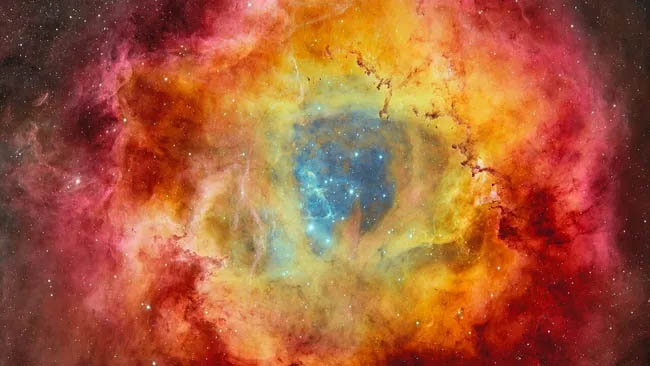Science: The Rosette Nebula blooms in deep space, captured in this amazing image taken by the High-Resolution Dark Energy Camera, which shows how the hot, bright stars at the center of the Rosette are energizing the molecular gas surrounding it. The Rosette Nebula is a welcome sight for astrophotographers because it rises in the Northern Hemisphere winter sky in the constellation of Monoceros, the Unicorn, which is southeast of Orion and lies inside the Winter Triangle formed by the stars Sirius, Procyon and Betelgeuse.
Located about 5,000 light-years away, the Rosette Nebula seems fleeting when viewed through a telescope’s eyepiece, a ghostly ring at the very edge of detectability due to its low surface brightness. However, it really shows its potential when imaged at long exposures, appearing even more spectacular in this view captured by the Dark Energy Camera (DECam) mounted on the four-meter Victor M. Blanco Telescope at the Cerro Tololo Inter-American Observatory in Chile.
The 500-megapixel resolution of DECam shows the Rosette in all its splendor. The reason for its name is obvious. Unlike many deep-sky objects, the Rosette Nebula really looks like what it’s named: a giant wreath of gas and dust, 130 light-years across. The Rosette is a region of star formation. At its center is a star cluster, NGC 2244, which contains many hot, blue, massive young stars; unlike its surrounding nebulae, the star cluster is visible to amateur astronomers through binoculars or even with the unaided eye from a dark location.
Winds of radiation emanating from that star cluster are ionizing the gas in the rosette and have, in effect, cleared the hole in the middle of the nebula. The radiation energizes the gas, causing different gases to glow, or emit, at specific wavelengths, so such nebulae are called “emission nebulae.” The filters used in this image capture emission from hydrogen (red), oxygen (golden yellow) near the nebula’s central cavity, and ionized silicon near the nebula’s edge (pink). Of course, there are other gases within this molecular cloud that were not detected this time.
